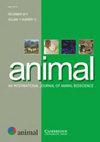Interactions between broiler parent stock age and egg pre-incubation duration: effects on embryo development, hatchability, day-old chick weight, and yolk sac weight
IF 4
2区 农林科学
Q1 AGRICULTURE, DAIRY & ANIMAL SCIENCE
引用次数: 0
Abstract
Egg storage is a common practice in commercial hatcheries, but prolonged storage can negatively impact hatchability, causing a significant problem for the poultry industry. Repeated pre-incubation could mitigate the decline depending on the age of the parent stock. The study investigated the interactions between parent stock age (30, 45, and 58 weeks) and repeated pre-incubation on the hatchability and embryo development of 15-day stored eggs from Ross 308 parent stock. Three different pre-incubation durations were employed during storage: no pre-incubation and twice at the 5th and 10th days of egg storage for either 4 or 8 h. For each parent stock age, 3 600 eggs collected on the same day from the same parent stock were used for hatchability assessment. The duration of pre-incubation was determined as the eggshell temperature increased from 28 °C to a maximum of 35 °C and then cooled to 28 °C; the persistency at 35 °C was either 1 or 4 h for the total pre-incubation period. The hatchability of both set and fertile eggs and early, middle, and late embryonic mortality depended on the parent stock’s age (P < 0.001). Pre-incubation alone did not have any impact on hatchability. Conversely, a significant interaction was observed between parent stock age and pre-incubation duration on the hatchability of fertile eggs (P = 0.001). At 30 weeks of parent stock age, both durations of pre-incubation positively influenced the hatchability. At 45 weeks of parent stock age, pre-incubation length had no effect on hatchability. At 58 weeks of parent stock age, a longer pre-incubation period, 2 × 8 h, was associated with decreased hatchability. Early embryonic mortality was not influenced by pre-incubation. However, a significant interaction was observed (P = 0.003). At 30 weeks of parent stock age, both short and long lengths of pre-incubation were associated with a decrease in early embryonic mortality. However, at 45 and 58 weeks, pre-incubation did not significantly affect early embryonic mortality. Additionally, longer pre-incubation periods significantly increased middle mortality compared to untreated eggs (P = 0.035). The median of embryo development for untreated eggs was the same across all ages (stage 10). In the older parent stock (45 and 58 weeks), repeated pre-incubation increased variability in embryo development, while in the younger parent stock, repeated pre-incubation decreased variability in embryo development. In conclusion, the duration and the frequency of pre-incubation should be specified based on the age of the parent stock.
肉鸡父母代种鸡年龄与蛋孵化前持续时间之间的相互作用:对胚胎发育、孵化率、鸡苗体重和卵黄囊重量的影响
鸡蛋储存是商业孵化场的常见做法,但长期储存会对孵化率产生负面影响,给家禽业带来严重问题。重复预孵化可缓解孵化率下降,但这取决于亲本的年龄。该研究调查了父母代种鸡年龄(30、45 和 58 周)和重复预孵化对罗斯 308 父母代种鸡 15 天贮存蛋的孵化率和胚胎发育的影响。在贮存过程中采用了三种不同的预孵化时间:不进行预孵化,在卵贮存的第 5 天和第 10 天进行两次预孵化,每次 4 或 8 小时。孵化前的持续时间由蛋壳温度从 28 ℃ 升至最高 35 ℃,然后降温至 28 ℃ 决定;在整个孵化前的持续时间中,35 ℃ 的持续时间为 1 或 4 h。套卵和受精卵的孵化率以及早期、中期和晚期胚胎死亡率取决于亲本的年龄(P < 0.001)。单独的预孵化对孵化率没有任何影响。相反,亲鱼年龄和预孵化时间对受精卵的孵化率有明显的交互作用(P = 0.001)。在 30 周亲鱼鱼龄时,两种预孵化持续时间都对孵化率有积极影响。在 45 周亲鱼鱼龄时,预孵化期的长短对孵化率没有影响。在亲本种群年龄为 58 周时,预孵化期越长(2 × 8 小时),孵化率越低。早期胚胎死亡率不受预孵化期的影响。然而,观察到了明显的交互作用(P = 0.003)。在亲本 30 周龄时,预孵化时间长短都与早期胚胎死亡率下降有关。然而,在 45 周和 58 周时,预孵化对早期胚胎死亡率没有显著影响。此外,与未处理的卵子相比,较长的预孵化期会显著增加中期死亡率(P = 0.035)。未处理卵的胚胎发育中位数在所有年龄段(第 10 阶段)均相同。在年龄较大的亲本种群(45 周和 58 周)中,重复预孵化增加了胚胎发育的可变性,而在年龄较小的亲本种群中,重复预孵化降低了胚胎发育的可变性。总之,应根据亲本种群的年龄来确定预孵化的持续时间和频率。
本文章由计算机程序翻译,如有差异,请以英文原文为准。
求助全文
约1分钟内获得全文
求助全文
来源期刊

Animal
农林科学-奶制品与动物科学
CiteScore
7.50
自引率
2.80%
发文量
246
审稿时长
3 months
期刊介绍:
Editorial board
animal attracts the best research in animal biology and animal systems from across the spectrum of the agricultural, biomedical, and environmental sciences. It is the central element in an exciting collaboration between the British Society of Animal Science (BSAS), Institut National de la Recherche Agronomique (INRA) and the European Federation of Animal Science (EAAP) and represents a merging of three scientific journals: Animal Science; Animal Research; Reproduction, Nutrition, Development. animal publishes original cutting-edge research, ''hot'' topics and horizon-scanning reviews on animal-related aspects of the life sciences at the molecular, cellular, organ, whole animal and production system levels. The main subject areas include: breeding and genetics; nutrition; physiology and functional biology of systems; behaviour, health and welfare; farming systems, environmental impact and climate change; product quality, human health and well-being. Animal models and papers dealing with the integration of research between these topics and their impact on the environment and people are particularly welcome.
 求助内容:
求助内容: 应助结果提醒方式:
应助结果提醒方式:


